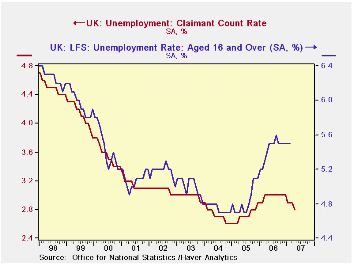 Global| May 16 2007
Global| May 16 2007UK "Claimant"-Based Unemployment Down, but Total Employment Sagging
Summary
Employment in the UK fell by 1,000 in the February period, a third successive monthly decrease in this 3-month moving average. Over the last three months (the style of comparison that the UK's Office for National Statistics [ONS] [...]

Employment in the UK fell by 1,000 in the February period, a third successive monthly decrease in this 3-month moving average. Over the last three months (the style of comparison that the UK's Office for National Statistics [ONS] generally emphasizes) employment was down by 55,000 and reached the lowest monthly level since last June. Notably, though, full-time work has held virtually steady October, and it is part-time work that has been cut.
The unemployment rate, measured by the ILO definition, has held flat at 5.5% since September, and in fact, with the exception of a 5.6% reading last August, has been 5.5% since last May, again using a 3-month moving average. The number unemployed has hovered close around 1.7 million. At the same time, the more popular unemployment gauge in the UK, the "claimant count rate", has edged lower. In April, this rate, reported as a figure covering just a single month, was 2.8%, down from 2.9% in March and 3.0% during nearly all of 2006.The number of "claimants" for April was 890,000, the first dip below 900,000 since October 2005. At least one press report today argued that the improvement in these latter jobless statistics would give the Bank of England room to raise interest rates in coming months to keep inflation down. However, another press service noted a modest slowing in earnings growth, which would limit the Bank's need to act.
Job vacancies suggest that the employment environment may do better. Reported vacancies amounted to 647,400 in April, up 20,000 from three months ago. The clearest gains appear in wholesale & retail trade, hotels and restaurants and in public services, such as health care. The financial sector is also on a steady, but more gradual uptrend. Manufacturing even has seen some increase. Thus, despite the flat pattern in the broad employment measure, these vacancy data point toward some improvement.
| UK Labor Force Survey & Related Labor Data | Jan 2007 | Dec 2006 | Nov 2006 | Oct 2006 | Year Ago | 2006 | 2005 | 2004 |
|---|---|---|---|---|---|---|---|---|
| Employment* (3Mo Avg, SA, Thous) |
-- | -- | 28,981 | 28,982 | 28,887 | 28,960 | 28,730 | 28,465 |
| Chg from 1 & 3 Months Ago | -- | -- | -1/-44 | -40/-47 | +8 (MoAvg)0.3% y/y |
0.8% | 0.9% | 1.0% |
| Unemployment Rate* (3Mo Avg, SA, %) |
-- | -- | 5.5% | 5.5% | 5.2% | 5.4% | 4.8% | 4.8% |
| Claimant Count (Monthly, Thous) |
890.0 | 905.7 | 920.0 | 923.1 | 947.1 | 944.7 | 861.7 | 853.3 |
| Claimant Count Rate (SA, %) | 2.8 | 2.9 | 2.9 | 2.9 | 3.0 | 3.0 | 2.7 | 2.7 |
| Vacancies (Monthly, Thous) | 637.7 | 602.8 | 590.7 | 619.1 | 598.8 | 599.4 | 618.6 | 631.9 |
Carol Stone, CBE
AuthorMore in Author Profile »Carol Stone, CBE came to Haver Analytics in 2003 following more than 35 years as a financial market economist at major Wall Street financial institutions, most especially Merrill Lynch and Nomura Securities. She has broad experience in analysis and forecasting of flow-of-funds accounts, the federal budget and Federal Reserve operations. At Nomura Securites, among other duties, she developed various indicator forecasting tools and edited a daily global publication produced in London and New York for readers in Tokyo. At Haver Analytics, Carol is a member of the Research Department, aiding database managers with research and documentation efforts, as well as posting commentary on select economic reports. In addition, she conducts Ways-of-the-World, a blog on economic issues for an Episcopal-Church-affiliated website, The Geranium Farm. During her career, Carol served as an officer of the Money Marketeers and the Downtown Economists Club. She has a PhD from NYU's Stern School of Business. She lives in Brooklyn, New York, and has a weekend home on Long Island.





